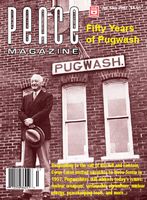
Peace Magazine Jul-Sep 2007, page 27. Some rights reserved.
Search for other articles by James Young here
By Mark Kurlansky; foreword by His Holiness the Dalai Lama. New York: Modern Library, 2006.
In the 1930s, in what is now Pakistan, the Pashtun leader Abdul Ghaffar Khan, "recruited the world's first nonviolent army, the Khudai Khidmatgars, the Servants of God," to resist British rule. An associate of Gandhi, Khan told his followers, "That man is a Muslim who never hurts anyone by word or deed...."
Khan is one of the fascinating figures in New York City writer Mark Kurlansky's Nonviolence: Twenty-five Lessons from the History of a Dangerous Idea.
In roughly 200 pages, Kurlansky has created an engaging overview of nonviolent ideas and actions from ancient India to the present. Peace activists will feel connected to the ongoing chorus of anti-war voices.
A multi-talented author, Kurlansky is best known for his historical non-fiction, with titles like Cod and Salt. With Nonviolence, the writing is excellent: the narrative flows along well, peppered with pithy quotes. While not always completely original or universally applicable, the twentyfive lessons give pause for reflection.
Early chapters focus on religious beliefs supporting nonviolence, found at the core of the world's major religions. Here, Kurlansky argues that when the state embraces a religion, that faith loses its nonviolent teachings.
With Christianity, the change from "turn the other cheek" begins as the religion becomes legal under Constantine, and develops as St. Augustine invents the "just war" theory. By the eleventh century, theologians were affirming that the killing of "false Christians" actually pleased God.
In the thirteenth century, for example, the Catholic Church began exterminating the Cathars of southern France. The Church demonized the nonviolent Cathars by claiming these dissenters worshipped cats, kissing them on the anus--a medieval example of the attack ad, making the Swift Boat accusations look mild in comparison!
Later chapters document religious and secular efforts to promote nonviolence during the American Revolution, the colonization of the non-European world and the anti-slavery movement. Then there are the nascent peace movements in 19th century North America and Europe.
In the modern era, Kurlansky recounts Gandhi's success in India, and campaigns by American activists like A.J. Muste and Martin Luther King. Overall, Gandhi's philosophy has informed the movements for civil rights and the environment, and those against the Vietnam War and nuclear weapons.
Nonviolence concludes with an all-too-brief look at how mass protests were instrumental in obtaining democracy in Eastern Europe and elsewhere.
Always stimulating, Nonviolence suffers from a major flaw. That legendary high school English teacher, Mrs. Griswold, would wield her red pen and comment: "Mr. Kurlansky--stay on topic!"
The book digresses from nonviolence proper by refuting mainstream historical narratives (the American Revolution was brutal, not benign) and creating too many "what if" scenarios (what if peaceful reforms had ended slavery?)
(Speaking of digressions and "what if" scenarios, what if Hans Blix and other UN weapons inspectors had practiced nonviolent resistance and remained in Iraq in 2003 as the U.S. planned to attack? What then?)
Kurlansky's own wanderings yield unfortunate results. It becomes impossible to examine nonviolent leaders and tactics in depth: for example, Thoreau and Tolstoy merit only brief mentions; Gandhi gets a light treatment; modern theorists, like Gene Sharp, are absent.
Nonviolence also fails to rigorously evaluate which peaceful tactics are effective. Aside from the moral superiority of nonviolence, there remain fundamental questions for both adherents and skeptics: Does nonviolence work? How well? When?
Kurlansky is at his weakest when he asserts that nonviolence helped or could have helped save Jews from the Holocaust, echoing arguments advanced by Gandhi and rebutted by Orwell at the time.
When Kurlansky seems unwilling to acknowledge the limits of nonviolence, critics are likely to dismiss all peaceful tactics as the imaginings of starry-eyed dreamers, who refuse to live in "the real world."
Despite its shortcomings, Nonviolence is worthy of discussion.
In the 1990s, after largely nonviolent actions had helped give birth to democracies in the former Soviet bloc, these peaceful methods became part of popular discourse. Since 9/11, however, we have been dominated by military solutions; only violence can deliver lasting peace, or so we are told. With the war on terror serving up a nauseating mix of torture, carnage and hatred, nonviolent ideas and strategies deserve mainstream attention once again. Kurlansky's book is a start.
Reviewed by James Young, a Vancouver-based writer and activist.

Peace Magazine Jul-Sep 2007, page 27. Some rights reserved.
Search for other articles by James Young here